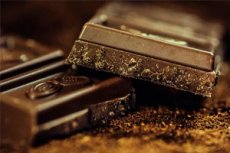Medical expert of the article
New publications
Chocolate for pancreatitis
Last reviewed: 03.07.2025

All iLive content is medically reviewed or fact checked to ensure as much factual accuracy as possible.
We have strict sourcing guidelines and only link to reputable media sites, academic research institutions and, whenever possible, medically peer reviewed studies. Note that the numbers in parentheses ([1], [2], etc.) are clickable links to these studies.
If you feel that any of our content is inaccurate, out-of-date, or otherwise questionable, please select it and press Ctrl + Enter.

It is difficult to imagine our life without chocolate. It was discovered long ago by the people of Central and South America, and it came to Europe later. And now, over more than half a century of history, it has finally won our hearts and stomachs. Those who do not eat the bar product so often are its consumers one way or another: it is in cakes, creams, candies, other confectionery products and simply by drinking a cup of hot cocoa. The logical question arises: can people diagnosed with pancreatitis have it, because the pathology imposes many restrictions on nutrition?
Is it possible to eat chocolate if you have pancreatitis?
To answer it, you need to know what is in the raw materials for chocolate, and the effect of each component on the organ. Cocoa contains about 300 different substances. More than half (54%) are fats, almost 12% proteins, in descending order are cellulose, starch, polysaccharides, tannins, water, minerals, organic acids. It contains the least caffeine (0.2%).
The caloric content of the grains is quite high - 565 kcal. Depending on the recipe, sugar, vanilla, vegetable oils, lecithin, pectin, raisins, various nuts, preservatives and flavorings are used in the production of chocolate.
All this clearly indicates that sweets should not be eaten during periods of exacerbation. Chronic pathology with stable remission allows certain varieties in limited doses and with certain reservations. Aggravation of the pathology with another one - cholecystitis - makes it a completely prohibited product. [ 1 ]
How does chocolate affect the pancreas?
Unfortunately, chocolate cannot be called "tolerant" to the organ. Its components such as caffeine and oxalates, including oxalic acid, stimulate excessive activity of enzyme secretion, which is unacceptable, as it can lead to pancreatic necrosis. Adding fats and nuts makes the product difficult to digest, increases the load on it. Fast carbohydrates force the pancreas to produce insulin more intensively, which is fraught with a violation of carbohydrate metabolism.
Cholecystitis, although a different pathology, is related to inflammation of the pancreas. Disruptions in the digestive tract often affect both organs involved in the process of digesting food and absorbing its useful substances by the mucous membranes. When the gallbladder is inflamed, the outflow of bile is difficult, and chocolate generally promotes the formation of stones, which can ultimately lead to complete blockage of the duct.
For those who have only been diagnosed with pancreatitis, there is an opportunity to choose for themselves those types of delicacies whose composition minimizes the negative impact on the pancreas. Of course, we are not talking about acute manifestations of the disease, but their stable absence.
Benefits
Chocolate can rightfully be considered a catalyst for good mood and joy. In addition, its benefits have been scientifically proven:
- for the heart and circulatory system - makes blood vessels more elastic, reduces cholesterol and the risk of strokes;
- enriches the body with minerals - especially rich in iron (100g contains about 70% of the daily requirement), potassium, selenium, zinc;
- effective for weight loss - a small piece gives a feeling of satiety;
- relieves stress;
- prevents the development of diabetes;
- improves brain function;
- fights inflammation. [ 2 ], [ 3 ]
White chocolate for pancreatitis
This variety is made from cocoa butter without adding powder, using dry milk, vanilla and sugar. The result is an ivory-colored bar with a pleasant caramel flavor. Unscrupulous manufacturers may add trans fats and not put cocoa products at all. In any case, due to the significant carbohydrate content, white chocolate is not recommended for patients.
Dark chocolate for pancreatitis
The cocoa content in this variety is 70% and higher. It has much less sugar and no milk. Due to this, it tastes bitter and is less caloric than others. It is dark chocolate without additives that is the most acceptable option for pathology. But you should not get too carried away with it, 40 mg (a third of a bar) of the proven product daily in the absence of symptoms of the disease for a long time. It is best to eat it after the main meal for dessert.
Candy for pancreatitis
This type of confectionery has thousands of names. But whatever they are: with filling, covered with glaze, chocolate, caramel, toffee, they contain 60% and more sugar. This makes candies a forbidden delicacy for pancreatitis. Such delicacies should be avoided even in the case of a sluggish inflammatory process of the organ.
Contraindications
Chocolate is not the best dessert for people who are overweight and do not know the limits in consuming sweets, or for diabetics. In addition, dark chocolate is a strong allergen, it is also contraindicated for migraines. [ 4 ]
What can I use to replace chocolate if I have pancreatitis?
If you still want something sweet, what can you replace chocolate with for pancreatitis? You can eat honey, natural sugar-free jellies, meringues, candied fruits, dried fruits, pastilles, marmalade, homemade jam, 20-30 g of halva in small doses. The latter, although quite fatty, is allowed during remission due to the presence of polyunsaturated fatty acids and vitamin E. It is an excellent source of energy for the body.
But you can't eat store-bought cakes. You need to bake them yourself, for example, sponge cake, soufflé or meringue, alternating layers of fruit or low-fat yogurt, cottage cheese.

